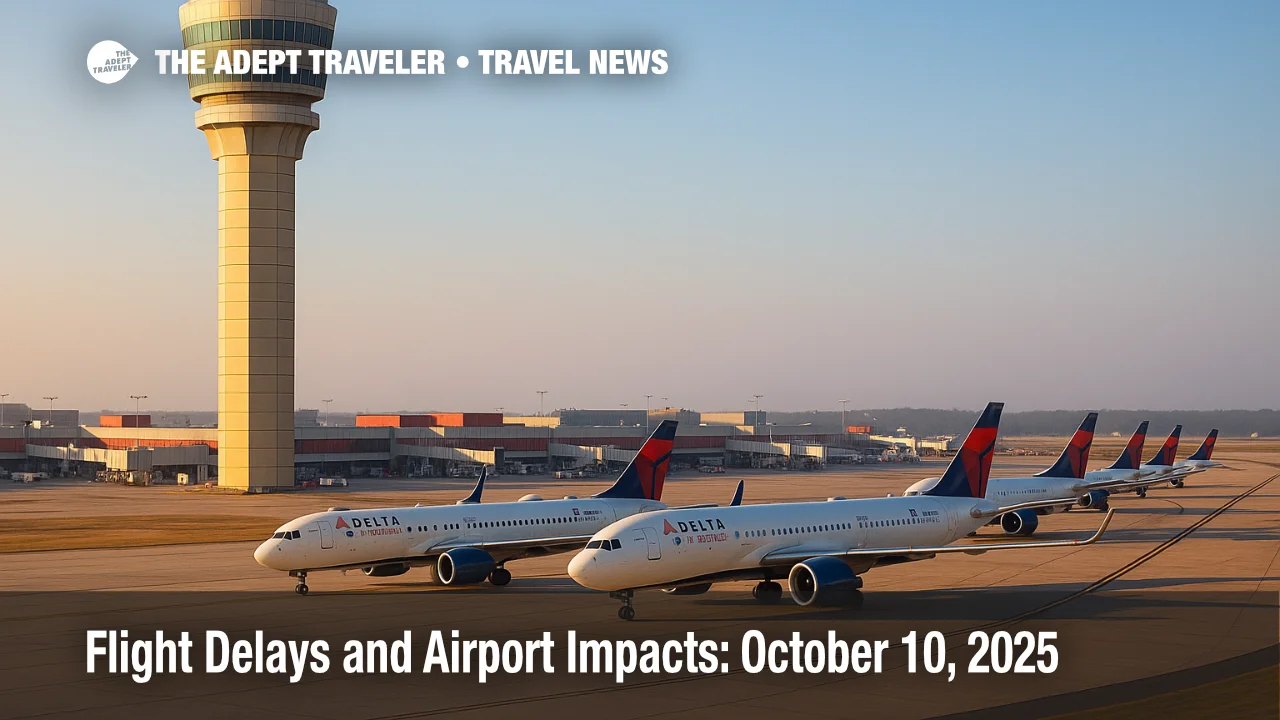Flight delays and airport impacts: October 11, 2025

Staffing constraints and scattered thunderstorms are back in the FAA's plan for Saturday. The agency flagged triggers for New York airspace, Dallas TRACON, and Atlanta TRACON this evening, with possible Ground Delay Programs at Boston Logan International Airport (BOS), plus potential initiatives at Harry Reid International Airport (LAS), Miami International Airport (MIA), and Fort Lauderdale-Hollywood International Airport (FLL). Low ceilings may slow Seattle-Tacoma International Airport (SEA), while storms could pinch flows around Phoenix Sky Harbor International Airport (PHX) and Salt Lake City International Airport (SLC).
Key points
- Why it matters: Multiple staffing triggers and storm cells raise the risk of metering and ground programs at key hubs.
- Travel impact: BOS and LAS may see GDPs; MIA and FLL could face initiatives into late evening; SEA has low ceilings.
- What's next: Evening traffic banks should ease after 8:00 p.m., but staffing limits in ZNY, D10, and A80 can extend delays.
- Route advisories include WEST_TO_PHL and South Florida CDRs; Atlantic Y-route closures are probable overnight.
- Construction continues at major fields, including BOS Runway 09/27 and MCO Runway 18R/36L, trimming arrival rates.
Snapshot
The FAA's Operations Plan Advisory for October 11 highlights evening staffing triggers: New York, Dallas TRACON, and Atlanta TRACON. Terminal constraints call for thunderstorms at MIA, FLL, SLC, LAS, and PHX, with low ceilings at SEA. The plan lists BOS and LAS as "possible" for a ground stop or delay program after 500 p.m. Eastern, and South Florida initiatives possible until 200 a.m. En route, thunderstorms affect multiple centers, and a previously announced Non-Restrictive Routing suspension remains in Washington Center airspace. Travelers should expect CDRs, SWAP, and arrival routes in the West and South Florida this evening.
Background
The system continues to operate under controller staffing strain that has forced conservative arrival rates at peak banks. Yesterday's tower evacuation at Hartsfield-Jackson Atlanta International Airport (ATL) caused a short ground stop and lingering delays, a reminder that even brief outages at a mega-hub can ripple nationwide. FAA statements this week reiterated that traffic will be slowed into some airports when staffing requires it. With the holiday weekend volume still elevated, flow managers are leaning on metering, miles-in-trail, and tactical reroutes to preserve safety margins.
Latest developments
Staffing triggers and storm risks shape Saturday evening flows
Today's plan starts with staffing triggers for Potomac TRACON's MTV sector, Dallas TRACON, New York Area A, and Atlanta TRACON, aligned with the late-day bank structure. Terminal constraints include storms in South Florida, Phoenix, Las Vegas, and Salt Lake City, plus low ceilings at Seattle. BOS and LAS are on watch for possible Ground Delay Programs after 500 p.m., while South Florida initiatives could last through 200 a.m. Eastern. Expect WEST_TO_PHL routing during the afternoon, with additional CDRs and SWAP likely in Las Vegas and Phoenix during the evening push.
Construction and airspace notes that could add friction
Runway and taxiway projects continue to trim throughput at several hubs, including BOS Runway 09/27, MCO Runway 18R/36L, IAH Runway 08R/26L, and SFO Taxiway Z. Washington Center's suspension of Non-Restrictive Routing remains in effect through October 31, which can increase filed-route mileage on East Coast flows. Space launch operations begin late tonight into Sunday from Florida and Texas, which may generate temporary airspace management measures if windows are active.
Analysis
Operational stress today is a mix of predictable and tactical constraints. Predictable, because staffing triggers in ZNY, D10, and A80 compress arrival rates during peak banks and tend to spill into miles-in-trail restrictions on inbound jet routes. Tactical, because thunderstorms around South Florida and the Desert Southwest force real-time reroutes and occasional ground stops when cells sit on departure gates. BOS is a special case; the runway 09, 27 closure limits flexibility, so even modest wind or visibility shifts can push the airport into a GDP. SEA's low ceilings usually resolve with daytime mixing, but morning cancellations or late equipment arrival can leave a residue of delays. If ATL's operation remains stable after Friday's tower evacuation, Southeast connections should normalize; however, any pop-up constraints there would have outsized effects due to its banked structure. Plan for buffers on connections through BOS, MIA, FLL, LAS, PHX, and SEA.
Final thoughts
Aim for mid-morning or late-evening departures to dodge the worst metering. For Boston Logan and Las Vegas, monitor for GDPs after 5:00 p.m. Eastern, and leave extra time at South Florida airports in case initiatives extend into the night. If you are connecting through Atlanta, check aircraft routing and crew status given yesterday's disruption. We will keep tracking staffing advisories, route programs, and coastal ceiling trends in this daily guide to flight delays and airport impacts.
